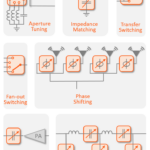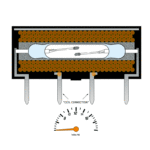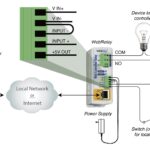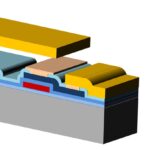Contactors are used for switching more than 15 amperes or in circuits rated more than a few kW. Except for optional auxiliary low-current contacts, contactors normally have open contacts and are used in high-power circuits. They include features to control and suppress the arc produced when interrupting heavy currents like those found in motor control and battery management in electric and hybrid vehicles, heating, ventilation, and air conditioning (HVAC) systems, locomotives, elevator control, and a variety of defense and aerospace systems.
This FAQ begins with a general description of contactor operation and an overview of the differences between IEC and NEMA contactor definitions, then looks at arc suppression. It presents how general-purpose contactors differ from definite-purpose contactors and closes with a review of how contactors are used in combination with relays in electric vehicle battery chargers and drive trains.
Contactors are heavy-duty electromechanical relays designed for direct connection to high current and high voltage loads. Standard electromechanical relays can switch up to 15 amperes and a couple of kilowatts and have a variety of contact designs, including normally open (Form A), normally closed, latching, bistable, and so on. Contactors can include auxiliary contacts for lower power circuits, but the main contacts are always Form A and are designed to suppress the arc produced when interrupting heavy currents.
Contactors are specially designed and range in size from small models a few inches on a side to very high-power devices that can be one meter in diameter (Figure 1). Current ratings range to 5,000 amps or more; voltage ratings can be thousands of volts. High-power contactors can handle over 100 kW. A typical contactor may interface between 24 Vdc control circuitry and a 480-V motor.
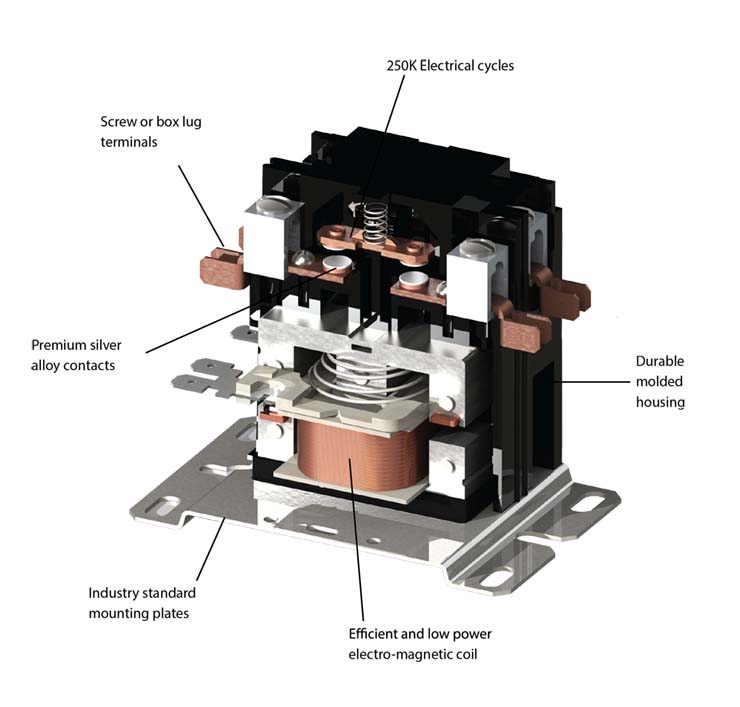
IEC vs. NEMA
The National Electrical Manufacturers Association (NEMA) and the International Electrotechnical Commission (IEC) have different approaches to classifying contractors. NEMA contactors tend to be larger and more expensive than IEC contactors. In addition, the IEC 60947 standard has more size classifications compared with the ten classifications recognized by NEMA. The more numerous classifications relate more closely to specific application scenarios. NEMA requires safety covers on contactor terminals, while IEC contactors must be inherently “finger safe”. IEC contactors are needed to react faster when overloads occur, while NEMA contactors are required to have a higher tolerance of short circuit conditions.
Under the IEC system, contactor ratings depend on the utilization category. Examples include:
- AC-1 – Non-inductive or slightly inductive loads like resistance furnaces
- AC-2 – Starting of slip-ring motors
- AC-3 – Starting of squirrel-cage motors and switching off after the motor is up to speed. These contactors are rated for making locked rotor amps (LRA) and breaking full-load amps (FLA).
- AC-4 – Starting of squirrel-cage motors with inching and plugging duty, including rapid start & stop and making and braking LRA.
- AC-11 – Auxiliary contacts for control circuits
NEMA contactors for low-voltage motors (less than 1kV) are rated according to NEMA size, from 00 to 9, which gives a maximum continuous current rating, ratings by horsepower for 230 Vac and 460 Vac induction motors, and are based on standardized duty cycles (Table 1).
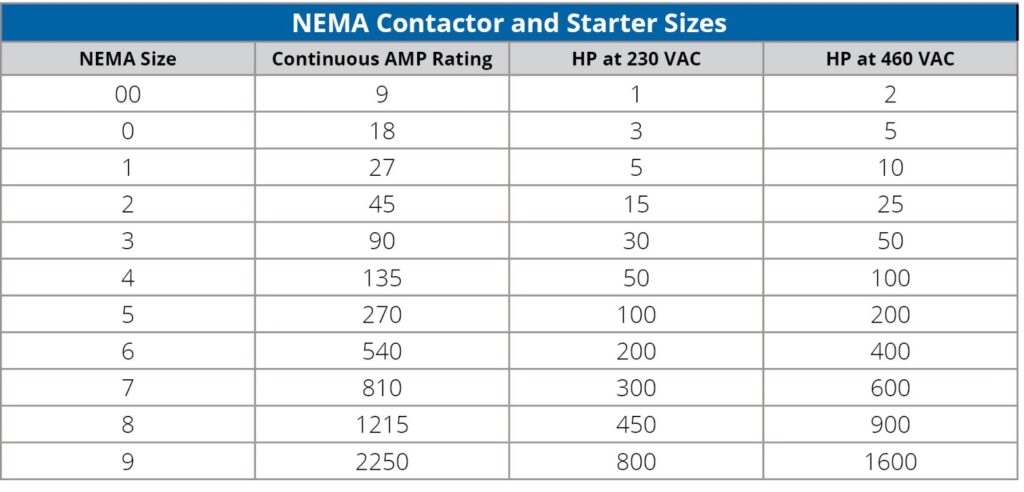
The NEMA sizes are limited in their applicability. Higher than standard duty cycles or specialized non-induction motors may require a larger contactor. Contactors for motors over 1kV (called medium-voltage) are rated by voltage and current, not by horsepower. In addition, contactors for other applications, such as power factor correction capacitors or lighting systems, are specified by the system makers and are not included in the NEMA standard. NEMA rated contactor auxiliary contacts using a letter plus a three-digit number. The letter indicates the current rating and whether the current is AC or DC, and the number delineates the maximum voltage rating.
Arc suppression
The high power handled by contactors necessitates the implementation of arc suppression. Without proper arc suppression, the contacts can become degraded. An arc between the contacts occurs when they are opened or closed. A break arc that occurs when the contacts are opened is more energetic and, therefore, more destructive.
An arc generates a temperature of tens of thousands of degrees and slowly destroys the contacts with the repeated operation. For example, the basic mechanical lifetime of a contactor with no power applied can reach 20 million switching operations. With proper arc management, that same contactor will have a lifetime of 10,000 to 100,000 operations when operated at its rated current and voltage.
Arc suppression and management are implemented differently depending on the operating voltage of the contactor. For low-voltage motor control contactors rated 600 Vac or less, air at atmospheric pressure is used to extinguish the break arc. Medium voltage (under 1kVac) contractors use a vacuum to extinguish the arc. Contactors rated for over 1kVac may use a vacuum or an inert gas. Contactors rated for over 600 Vdc use air combined with specially designed contactor geometries to break the arc energy.
Definite purpose vs. general purpose
General purpose (GP) contactors conforming to the NEMA and IEC ratings are suitable for motors operating with standard duty cycles. Motors used in HVAC applications have lighter duty cycles compared to the standard duty cycle used for rating GP contactors. Definite purpose (DP) contactors have been designed for the light-duty cycles found in HVAC systems. In addition, NEMA and IEC ratings for GP contactors are based on different design approaches. NEMA GP contactors are designed for simplicity of use and extended operating lifetimes, while many IEC GP contactors are designed to be easily replaceable. NEMA DP and IEC GP contactor ratings are based on the expected life cycle of the system where the contactor is used. Some other differences between GP and DP contactors include:
- DP contactors are UL recognized, not listed.
- GP contactors tend to be smaller than DP contactors (Figure 2)
- DP contactors generally have shorter service lives than GP contactors
- DP contactors cost less than GP contactors

There are two primary categories of DP contactors:
- Compact devices with 1 or 2 poles rated for up to 40 A are primarily designed for residential HVAC systems.
- Standard frame devices with 2 or 3 poles rated up to several hundred amps are designed for use in commercial and industrial centralized air conditioning systems.
While GP contactors are rated relative to the HP of the motor, DP contactors are rated based on the motor FLA. DP contactors are more limited relative to the maximum LRA rating. As a result, IEC GP contactors with similar FLA ratings can control larger motors than corresponding DP contactors. Standard DP contactors are available with FLA ratings of 20, 25, 30, 40, 50, 60, 75, and 90 A and AC coil voltages of 120, 208/240, 480, and 575, as well as some DC voltages.
Contactors for EVs
When contactor makers think of vehicles, they often start with locomotives, followed by heavy-duty mining and industrial vehicles and ships, and then electric and hybrid cars and trucks. One application for contactors in all these vehicles is to open during a short circuit load (these can reach 3kA and more), protecting high voltage and high wattage electronic power converters or large battery packs and nearby users and occupants. Protection can be needed during normal operation if a fault occurs or during a vehicle crash.
Contactors are also used to control inrush currents upon startup. Typical EV battery chargers, DC/DC converters, and motor drive designs include a bank of filter capacitors that can draw a very large inrush current. In a typical design, a pre-charge relay (or a contactor in large systems like locomotives) and a series resistor are used to control the charging of the filter capacitors. Once the capacitors have reached 80 to 90% of full charge, the relay turns off, and the main contactors turn on (Figure 3). When the vehicle is turned off, the main contactors open, isolating the electronics from the battery or other energy source.
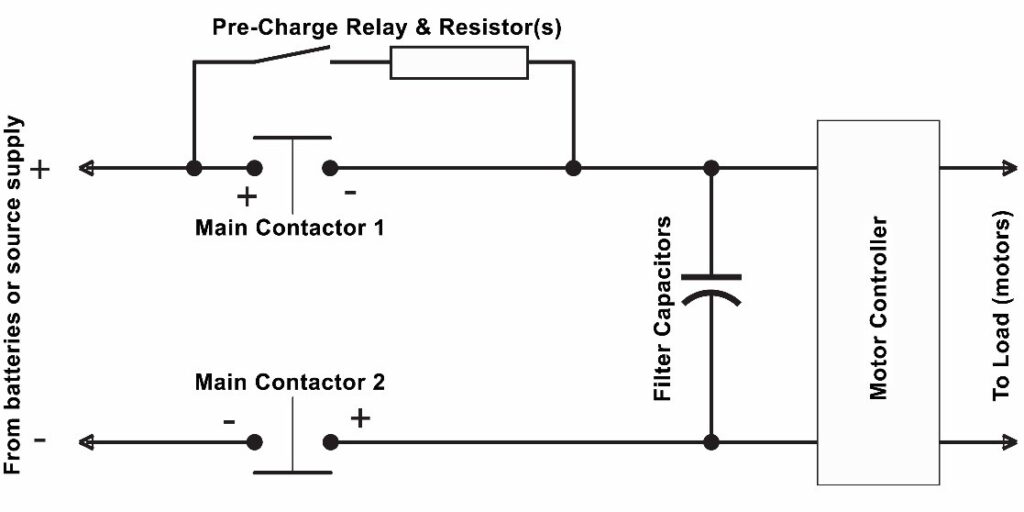
Summary
The higher power handling ability of contactors compared to conventional electromagnetic relays results in several design and application differences. Arc suppression is a major consideration for contactors and is usually not nearly as important for relays. The IEC and NEMA have different approaches to classifying GP contactors, and the IEC does not recognize DP contactors. In the U.S., DP contactors have emerged to provide a lower-cost alternative for HVAC applications. Contactors are important components promoting many electric vehicles’ safe and reliable operation.
References
Contactor, Wikipedia
Contactors in electric vehicles, Cotronics
Control series contractors, Wilspec Technologies
Definite Purpose Contactors, C3Controls
NEMA vs. IEC Motor Controls, C3Controls
Types of Contactors, TE Connectivity

